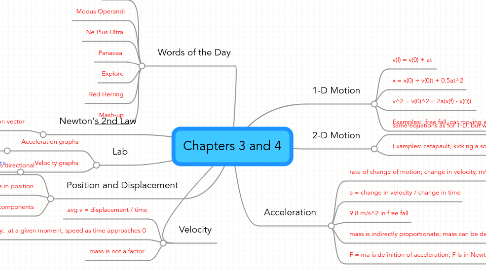Chapters 3 and 4
作者:Melissa Schultz


1. Newton's 2nd Law
1.1. Force vector = mass scalar * acceleration vector
2. Velocity
2.1. avg v = displacement / time
2.2. instantaneous velocity: at a given moment, speed as time approaches 0
2.3. mass is not a factor
3. Position and Displacement
3.1. position needs origin, not always directional
3.2. displacement is vector, change in position
3.3. can be found using vectors and x and y components
4. Words of the Day
4.1. Ithaca
4.2. Modus Operandi
4.3. Ne Plus Ultra
4.4. Panacea
4.5. Explore
4.6. Red Herring
4.7. Mash-up
5. Lab
5.1. Acceleration graphs
5.1.1. above x-axis is acceleration increasing, below is decreasing acceleration
5.2. Velocity graphs
5.2.1. parabolic identifies movement; open down is -a and open up is +a
6. Acceleration
6.1. rate of change of motion; change in velocity, m/s^2
6.2. a = change in velocity / change in time
6.3. 9.8 m/s^2 in free fall
6.4. mass is indirectly proportionate; mass can be defined as amount of resistance to change in motion
6.5. F = ma is definition of acceleration; F is in Newtons and a is m/s^2
7. 1-D Motion
7.1. v(f) = v(0) + at
7.2. x = x(0) + v(0)t + 0.5at^2
7.3. v^2 = v(0)^2 + 2a(x(f) - x(0))
7.4. Examples: free fall, car moving in x or y direction only
8. 2-D Motion
8.1. same equations as for 1-D, but with velocity and position for x and y separately
8.1.1. for y, a always is 9.8 m/s^2
